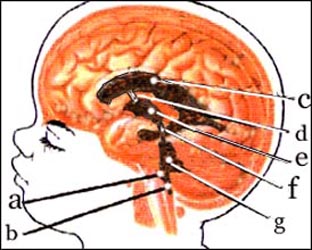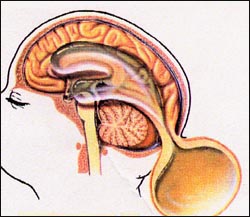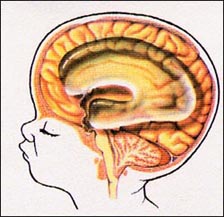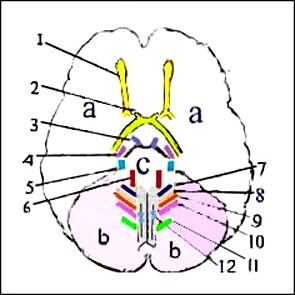수두증이 있는 병들, Diseases with hydrocephalus
1. 실비우스 뇌척수액 수도관 협착으로 생긴 수두증 Hydrocephalus due to stenosis of the aqueduct of sylvius
- 대뇌 속에 외측 뇌실, 제 3뇌실, 제 4뇌실 3가지 뇌실이 있다. 그 한 가지 뇌실과 다른 뇌실을 연결시키는 뇌척수액 수도관이 정상적으로 있다.
- 제 3뇌실과 제 4뇌실을 연결시켜 주는 수도관을 실비우스 수도관 또는 중뇌수도라고 한다(그림 1-95 참조).
- 실비우스 수도관이 선천성으로 좁아져서 제 3뇌실과 제 4뇌실 사이의 뇌척수액이 정상적으로 흐르지 않으면 뇌수종이 생길 수 있다.
- 성 염색체 약성으로 유전될 수 있다.
- 수두증(뇌수종/水頭症)과 선천성 뇌척수 기형 참조
2. 수아세포종으로 인해서 제 4뇌실이 막혀 생긴 수두증 Hydrocephalus due to obstructing the fourth ventricle by medulloblastoma
- 수아세포중(Medulloblastoma)은 소뇌에도 생길 수 있고, 성상세포종 다음으로 흔히 생기는 후두개종양이다.
- 제 4뇌실에 생길 수도 있고 소뇌로 퍼져날 수 있으며 제 4뇌실은 막아 수두증이 생길 수 있다.
- 수술 치료 및 방사선으로 치료한다.
3. 뇌기저와 뇌측면 지망막하강 유착으로 생긴 수두증 Hydrocephalus due to basal and convexity subarachnoid adhesions
-
수두증(뇌수종/水頭症)이 지주막(지망막)하강 유착으로 수두증이 생길 수 있다.
4. 후두부 뇌 헤르니아와 수두증 Occipital encephalocele and hydrocephalus
- 선천성으로 또는 후천성으로 후두부 뇌 실질의 일부가 후두 두개골에 있는 구멍을 통해서 두개골 밖으로 돌출되어 나오거나 탈출되면 후두부 뇌 헤르니아가 생길 수 있다.
- 후두부 뇌 헤르니아가 있으면 뇌수종이 생길 수 있다.
- 수두증(뇌수종/水頭症)과 선천성 뇌척수 기형 참조.

그림 1-95. 정상 뇌실
a-루시카 좌공, b-마젠디 공, c-측뇌실,
d-몬로 공, e-제 3뇌실, f-실비우스 수도관, g-제 4뇌실
출처: Ross Lab Columbus Ohio,USA와 소아가정간호백과

그림 1-96. 기저와 뇌 측면 지망막하 유착으로 생긴 수두증. 그림에서는 지망막하 유착이 생긴 부분이 보이지 않는다.
출처: Ross Lab Columbus Ohio,USA와 소아가정간호백과

그림 1-97. 뇌 후두부에 생긴 뇌 헤르니아
출처: Used with permission from Ross Lab Columbus Ohio, USA와 소아가정간호백과

그림 1-98. 아르놀드 키아리 기형
출처: Used with permission from Ross Lab Columbus Ohio, USA와 소아가정간호백과
5. 아르놀드-키아리 기형과 수두증 Arnold-Chiari malformation and hydrocephalus
- 아르놀드-키아리 기형으로 뇌수증이 생길 수 있다.
- 아르놀드-키아리 기형은 일종의 선천성 뇌 기형이다.
- 이 기형은 일형과 이형 두 가지의 형이 있다.
- 그 중, 제 이형은 진행성 수두증과 척수 수막류를 동반하는 것이 보통이다.
- 수두증(뇌수종/水頭症)과 선천성 뇌척수 기형 참조
6. 댄디-워커 증후군과 수두증 Dandy-walker syndrome and Hydrocephalus

그림 1-99. 뇌 측면 그림
대뇌, 소뇌, 중뇌, 뇌교, 연수, 제 3뇌실, 뇌간=중뇌+교뇌+연수
Copyright ⓒ 2013 John Sangwon Lee, M.D. FAAP
참조문헌; Gray’s Anatomy

그림 1-100. 뇌 저 전후면과 12쌍의 뇌신계의 그림 1~12는 12 쌍의 뇌신경의 기시부
a- 대뇌, b- 소뇌, c- 뇌교, d- 연수
Copyright ⓒ 2013 John Sangwon Lee, M.D. FAAP
참조문헌; Gray’s Anatomy, 그림 1-6참조
- 댄디-워커 증후군으로 뇌수종이 생길 수 있다.
- 댄디-워커 증후군을 댄디-워커변형(Dandy-Walker malformation)이라고도 한다.
- 대뇌에 있는 제 4뇌실의 낭종성 확장으로 생기는 일종의 선천성 뇌 기형이다.
- 이 기형이 있는 영유아들의 90%에서 뇌수종이 있을 수 있고 소뇌 무발육과 뇌량 무발육이 있을 수 있다.
- 뇌수종(수두증)으로 머리가 비정상으로 커질 수 있다.
- 신체발육 지연과 인지발육 지연 등이 생길 수 있다.
- 보행실조도 생길 수 있다.
- 수두증은 션트 완화 치료를 한다.
Diseases with hydrocephalus
1. Hydrocephalus due to stenosis of the aqueduct of sylvius
• There are three ventricles in the cerebrum, lateral ventricle, third ventricle, and fourth ventricle. There is normally a cerebrospinal fluid duct connecting that one ventricle to the other.
• The aqueduct that connects the 3rd ventricle and the 4th ventricle is called the Sylvian aqueduct or the midbrain (see Figure 1-95).
• Hydrocephalus can occur when the Sylvian aqueduct is congenitally narrowed and the cerebrospinal fluid between the 3rd and 4th ventricles does not flow normally.
• Can be inherited as a sex chromosome weakness.
• See hydrocephalus (hydrocephalus) and congenital cerebrospinal malformations.
2. Hydrocephalus due to obstructing the fourth ventricle by medulloblastoma
• Medulloblastoma can occur in the cerebellum and is the second most common epiglottis after astrocytoma.
• May develop in the 4th ventricle or spread to the cerebellum, and blockage of the 4th ventricle may result in hydrocephalus.
• Treatment with surgery and radiation.
3. Hydrocephalus due to basal and convexity subarachnoid adhesions
• Hydrocephalus can cause hydrocephalus due to adhesion of the arachnoid (retinitis) descending.
4. Occipital encephalocele and hydrocephalus4
• Occipital brain hernia can occur when a part of the occipital brain parenchyma protrudes or protrudes out of the skull through a hole in the occipital skull, either congenitally or acquired.
• Having an occipital brain hernia can cause hydrocephalus.
• See hydrocephalus (hydrocephalus) and congenital cerebrospinal malformations.

Figure 1-95. normal ventricle a-Lucica left foramen, b-Magenti foramen, c-lateral ventricle, d – Monroe ball, e – 3rd ventricle, f – Sylvian aqueduct, g – 4th ventricle Source: Ross Lab Columbus Ohio, USA and Encyclopedia of Pediatric and Family Nursing

Figure 1-96. Hydrocephalus resulting from basal and lateral subarachnoid adhesions. In the figure, the subretinal adhesion is not visible. Source: Ross Lab Columbus Ohio, USA and Encyclopedia of Pediatric and Family Nursing

Figure 1-97. Brain hernia in the back of the brain Source: Used with permission from Ross Lab Columbus Ohio, USA and Encyclopedia of Pediatric and Family Nursing

Figure 1-98. Arnold Chiari deformity Source: Used with permission from Ross Lab Columbus Ohio, USA and Encyclopedia of Pediatric and Family Nursing 5. Arnold-Chiari malformation and hydrocephalus
• Arnold-Chiari malformation can lead to hydrocephalus.
• Arnold-Chiari malformation is a type of congenital brain malformation.
• There are two types of this malformation: monomorphic and heteromorphic.
• Among them, type 2 is usually accompanied by progressive hydrocephalus and myeloma.
• See hydrocephalus (hydrocephalus) and congenital cerebrospinal malformations. 6. Dandy-walker syndrome and Hydrocephalus

Figure 1-99. brain side illustration Cerebellum, cerebellum, midbrain, pons, medulla oblongata, third ventricle, brainstem = midbrain + pons + medulla Copyright ⓒ 2013 John Sangwon Lee, M.D. FAAP references; Gray’s Anatomy

Figure 1-100.
Figures 1 to 12 of the base of the brain and 12 pairs of cranial nerves show the origin of 12 pairs of cranial nerves. a- cerebrum, b-cerebellum, c- pons, d-medulla Copyright ⓒ 2013 John Sangwon Lee, M.D. FAAP
references; See Gray’s Anatomy,
Figure 1-6.
• Dandy-Walker syndrome can cause hydrocephalus.
• Dandy-Walker syndrome is also called Dandy-Walker malformation.
• It is a type of congenital brain malformation caused by cystic expansion of the fourth ventricle in the cerebrum.
• In 90% of infants and toddlers with this malformation, hydrocephalus may be present and there may be agenesis of the cerebellum and aplasia of the corpus callosum.
• Hydrocephalus (hydrocephalus) can cause the head to grow abnormally.
• Delayed physical development and delayed cognitive development may occur. • Ataxia may also occur.
• Hydrocephalus is treated with shunt palliative care.
출처와 참조 문헌 Sources and references
- NelsonTextbook of Pediatrics 22ND Ed
- The Harriet Lane Handbook 22ND Ed
- Growth and development of the children
- Red Book 32nd Ed 2021-2024
- Neonatal Resuscitation, American Academy Pediatrics
- www.drleepediatrics.com 제1권 소아청소년 응급 의료
- www.drleepediatrics.com 제2권 소아청소년 예방
- www.drleepediatrics.com 제3권 소아청소년 성장 발육 육아
- www.drleepediatrics.com 제4권 모유,모유수유, 이유
- www.drleepediatrics.com 제5권 인공영양, 우유, 이유식, 비타민, 미네랄, 단백질, 탄수화물, 지방
- www.drleepediatrics.com 제6권 신생아 성장 발육 육아 질병
- www.drleepediatrics.com제7권 소아청소년 감염병
- www.drleepediatrics.com제8권 소아청소년 호흡기 질환
- www.drleepediatrics.com제9권 소아청소년 소화기 질환
- www.drleepediatrics.com제10권. 소아청소년 신장 비뇨 생식기 질환
- www.drleepediatrics.com제11권. 소아청소년 심장 혈관계 질환
- www.drleepediatrics.com제12권. 소아청소년 신경 정신 질환, 행동 수면 문제
- www.drleepediatrics.com제13권. 소아청소년 혈액, 림프, 종양 질환
- www.drleepediatrics.com제14권. 소아청소년 내분비, 유전, 염색체, 대사, 희귀병
- www.drleepediatrics.com제15권. 소아청소년 알레르기, 자가 면역질환
- www.drleepediatrics.com제16권. 소아청소년 정형외과 질환
- www.drleepediatrics.com제17권. 소아청소년 피부 질환
- www.drleepediatrics.com제18권. 소아청소년 이비인후(귀 코 인두 후두) 질환
- www.drleepediatrics.com제19권. 소아청소년 안과 (눈)질환
- www.drleepediatrics.com 제20권 소아청소년 이 (치아)질환
- www.drleepediatrics.com 제21권 소아청소년 가정 학교 간호
- www.drleepediatrics.com 제22권 아들 딸 이렇게 사랑해 키우세요
- www.drleepediatrics.com 제23권 사춘기 아이들의 성장 발육 질병
- www.drleepediatrics.com 제24권 소아청소년 성교육
- www.drleepediatrics.com 제25권 임신, 분만, 출산, 신생아 돌보기
- Red book 29th-31st edition 2021
- Nelson Text Book of Pediatrics 19th- 21st Edition
- The Johns Hopkins Hospital, The Harriet Lane Handbook, 22nd edition
- 응급환자관리 정담미디어
- Pediatric Nutritional Handbook American Academy of Pediatrics
- 소아가정간호백과–부모도 반의사가 되어야 한다, 이상원 저
- The pregnancy Bible. By Joan stone, MD. Keith Eddleman, MD
- Neonatology Jeffrey J. Pomerance, C. Joan Richardson
- Preparation for Birth. Beverly Savage and Dianna Smith
- 임신에서 신생아 돌보기까지. 이상원
- Breastfeeding. by Ruth Lawrence and Robert Lawrence
- Sources and references on Growth, Development, Cares, and Diseases of Newborn Infants
- Emergency Medical Service for Children, By Ross Lab. May 1989. p.10
- Emergency care, Harvey Grant and Robert Murray
- Emergency Care Transportation of Sick and Injured American Academy of Orthopaedic Surgeons
- Emergency Pediatrics A Guide to Ambulatory Care, Roger M. Barkin, Peter Rosen
- Quick Reference To Pediatric Emergencies, Delmer J. Pascoe, M.D., Moses Grossman, M.D. with 26 contributors
- Neonatal resuscitation Ameican academy of pediatrics
- Pediatric Nutritional Handbook American Academy of Pediatrics
- Pediatric Resuscitation Pediatric Clinics of North America, Stephen M. Schexnayder, M.D.
-
Pediatric Critical Care, Pediatric Clinics of North America, James P. Orlowski, M.D.
-
Preparation for Birth. Beverly Savage and Dianna Smith
-
Infectious disease of children, Saul Krugman, Samuel L Katz, Ann A.
- 제4권 모유, 모유수유, 이유 참조문헌 및 출처
- 제5권 인공영양, 우유, 이유, 비타민, 단백질, 지방 탄수 화물 참조문헌 및 출처
- 제6권 신생아 성장발육 양호 질병 참조문헌 및 출처
-
Neurology in Pediatrics, P. F. Bray, Yearbook Medical Publishers
-
Behavior Disorders in Children, Bakwin and Bakwin
- 소아과학 대한교과서
- 의학 용어사전 대한 의사 협회
Copyright ⓒ 2014 John Sangwon Lee, MD., FAAP
“부모도 반의사가 되어야 한다”-내용은 여러분들의 의사로부터 얻은 정보와 진료를 대신할 수 없습니다.
“The information contained in this publication should not be used as a substitute for the medical care and advice of your doctor. There may be variations in treatment that your doctor may recommend based on individual facts and circumstances.
“Parental education is the best medicine.